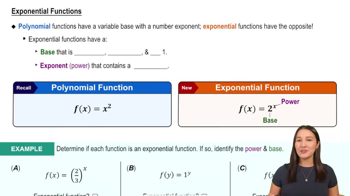Table of contents
- 0. Functions7h 52m
- Introduction to Functions16m
- Piecewise Functions10m
- Properties of Functions9m
- Common Functions1h 8m
- Transformations5m
- Combining Functions27m
- Exponent rules32m
- Exponential Functions28m
- Logarithmic Functions24m
- Properties of Logarithms34m
- Exponential & Logarithmic Equations35m
- Introduction to Trigonometric Functions38m
- Graphs of Trigonometric Functions44m
- Trigonometric Identities47m
- Inverse Trigonometric Functions48m
- 1. Limits and Continuity2h 2m
- 2. Intro to Derivatives1h 33m
- 3. Techniques of Differentiation3h 18m
- 4. Applications of Derivatives2h 38m
- 5. Graphical Applications of Derivatives6h 2m
- 6. Derivatives of Inverse, Exponential, & Logarithmic Functions2h 37m
- 7. Antiderivatives & Indefinite Integrals1h 26m
- 8. Definite Integrals4h 44m
- 9. Graphical Applications of Integrals2h 27m
- 10. Physics Applications of Integrals 2h 22m
0. Functions
Properties of Functions
Problem 1.13
Textbook Question
In Exercises 9–16, determine whether the function is even, odd, or neither.
𝔂 = x⁴ + 1
x³ - 2x
 Verified step by step guidance
Verified step by step guidance1
To determine if a function is even, odd, or neither, we need to analyze the function's symmetry. A function y = f(x) is even if f(-x) = f(x) for all x in the domain, and it is odd if f(-x) = -f(x) for all x in the domain.
Start by substituting -x into the function y = x⁴ + 1x³ - 2x. This gives us y = (-x)⁴ + 1(-x)³ - 2(-x).
Simplify the expression: (-x)⁴ = x⁴, (-x)³ = -x³, and -2(-x) = 2x. So, the expression becomes y = x⁴ - x³ + 2x.
Compare the simplified expression y = x⁴ - x³ + 2x with the original function y = x⁴ + 1x³ - 2x. Since f(-x) ≠ f(x) and f(-x) ≠ -f(x), the function is neither even nor odd.
Conclude that the function y = x⁴ + 1x³ - 2x is neither even nor odd based on the symmetry analysis.
 Verified video answer for a similar problem:
Verified video answer for a similar problem:This video solution was recommended by our tutors as helpful for the problem above
Video duration:
3mPlay a video:
Was this helpful?
Key Concepts
Here are the essential concepts you must grasp in order to answer the question correctly.
Even Functions
A function is considered even if it satisfies the condition f(-x) = f(x) for all x in its domain. This means that the graph of the function is symmetric with respect to the y-axis. For example, the function y = x² is even because substituting -x yields the same result as substituting x.
Recommended video:

Exponential Functions
Odd Functions
A function is classified as odd if it meets the condition f(-x) = -f(x) for all x in its domain. This indicates that the graph of the function is symmetric with respect to the origin. An example of an odd function is y = x³, as substituting -x results in the negative of the original function.
Recommended video:

Properties of Functions
Neither Even Nor Odd Functions
A function is neither even nor odd if it does not satisfy the conditions for either classification. This means that the function's graph lacks symmetry with respect to both the y-axis and the origin. For instance, the function y = x + 1 is neither even nor odd, as it does not exhibit the required symmetries.
Recommended video:

Properties of Functions

 6:21m
6:21mWatch next
Master Properties of Functions with a bite sized video explanation from Nick
Start learningRelated Videos
Related Practice

